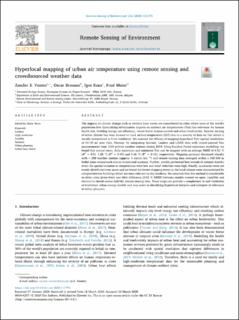| dc.contributor.author | Venter, Alexander Samuel | |
| dc.contributor.author | Brousse, Oscar | |
| dc.contributor.author | Esau, Igor | |
| dc.contributor.author | Meier, Fred | |
| dc.date.accessioned | 2020-03-27T09:05:21Z | |
| dc.date.available | 2020-03-27T09:05:21Z | |
| dc.date.issued | 2020 | |
| dc.identifier.issn | 0034-4257 | |
| dc.identifier.uri | https://hdl.handle.net/11250/2649032 | |
| dc.description.abstract | The impacts of climate change such as extreme heat waves are exacerbated in cities where most of the world's population live. Quantifying urbanization impacts on ambient air temperatures (Tair) has relevance for human health risk, building energy use efficiency, vector-borne disease control and urban biodiversity. Remote sensing of urban climate has been focused on land surface temperature (LST) due to a scarcity of data on Tair which is usually interpolated at 1 km resolution. We assessed the efficacy of mapping hyperlocal Tair (spatial resolutions of 10–30 m) over Oslo, Norway, by integrating Sentinel, Landsat and LiDAR data with crowd-sourced Tair measurements from 1310 private weather stations during 2018. Using Random Forest regression modelling, we found that annual mean, daily maximum and minimum Tair can be mapped with an average RMSE of 0.52 °C (R2 = 0.5), 1.85 °C (R2 = 0.05) and 1.46 °C (R2 = 0.33), respectively. Mapping accuracy decreased sharply with<250 weather stations (approx. 1 station km−2) and remote sensing data averaged within a 100-500 m buffer zone around each station maximized accuracy. Further, models performed best outside of summer months when the spatial variation in temperatures were low and wind velocities were high. Finally, accuracies were not evenly distributed over space and we found the lowest mapping errors in the local climate zone characterized by compact lowrise buildings which are most relevant to city residents. We conclude that this method is transferable to other cities given there was little difference (0.02 °C RMSE) between models trained on open- (satellite and terrain) vs closed-source (LiDAR) remote sensing data. These maps can provide a complement to and validation of traditional urban canopy models and may assist in identifying hyperlocal hotspots and coldspots of relevance to urban planners. | en_US |
| dc.language.iso | eng | en_US |
| dc.rights | Navngivelse 4.0 Internasjonal | * |
| dc.rights.uri | http://creativecommons.org/licenses/by/4.0/deed.no | * |
| dc.subject | landsat | en_US |
| dc.subject | high resolution | en_US |
| dc.subject | satellite | en_US |
| dc.subject | sentinel | en_US |
| dc.subject | urban planning | en_US |
| dc.subject | urban heat island | en_US |
| dc.title | Hyperlocal mapping of urban air temperature using remote sensing and crowdsourced weather data | en_US |
| dc.type | Journal article | en_US |
| dc.description.version | publishedVersion | en_US |
| dc.rights.holder | © 2020 The Authors. | en_US |
| dc.subject.nsi | VDP::Samfunnsvitenskap: 200::Samfunnsgeografi: 290 | en_US |
| dc.source.volume | 242 | en_US |
| dc.source.journal | Remote Sensing of Environment | en_US |
| dc.identifier.doi | 10.1016/j.rse.2020.111791 | |
| dc.identifier.cristin | 1803835 | |

